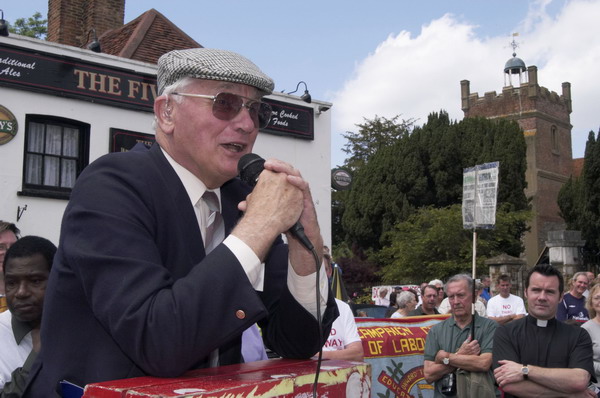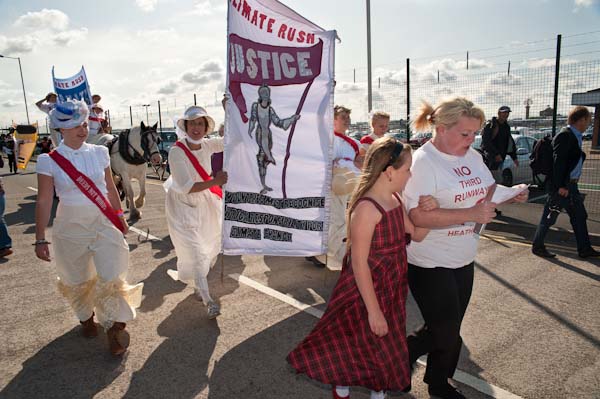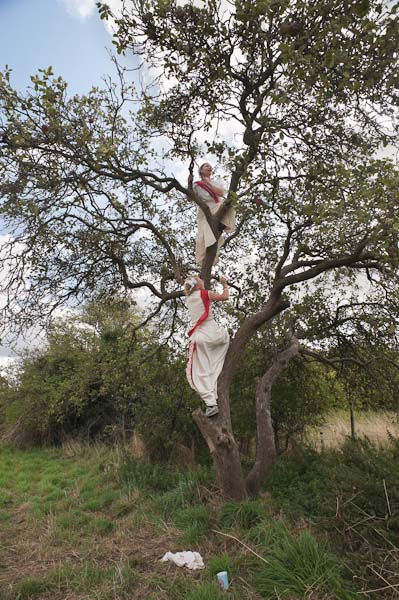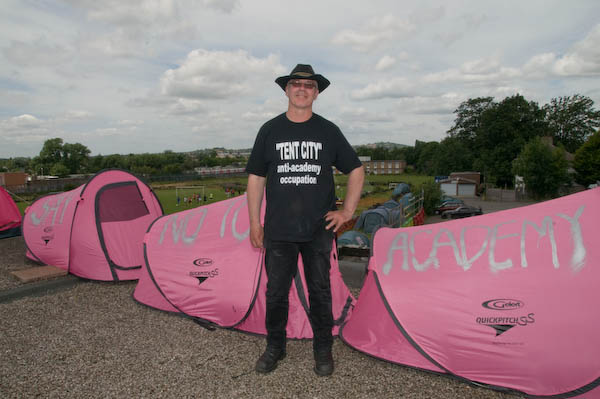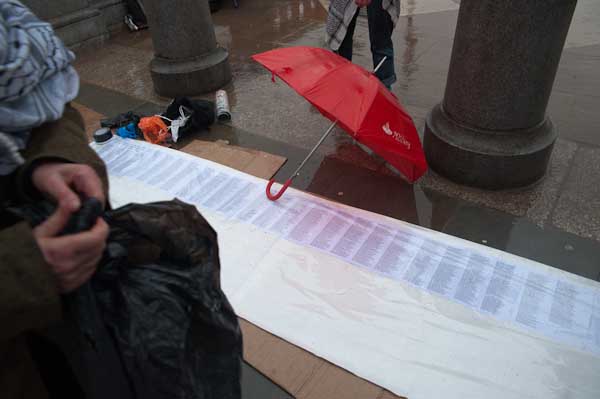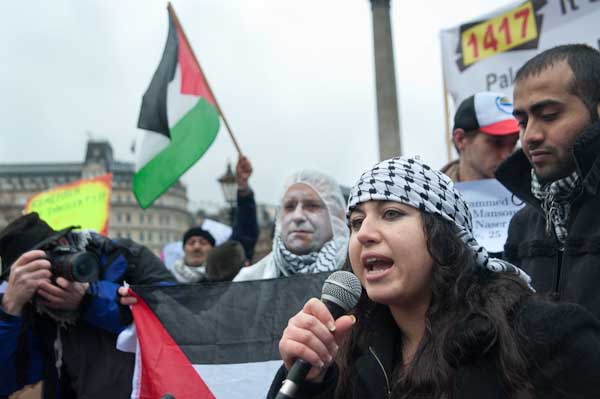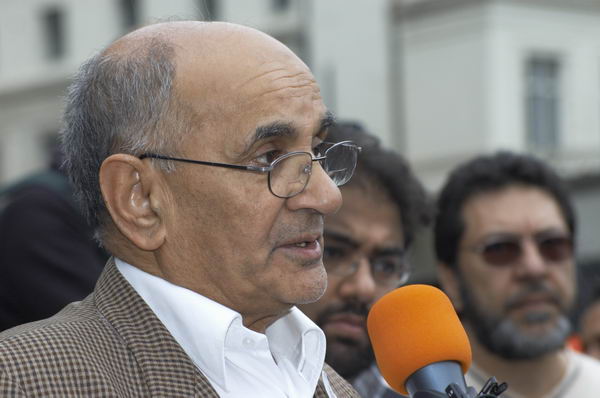Monday I took the train to Brighton, sometimes described as “London by the sea” which is pretty ludicrous as it has a very different feel to the capital. I did just glimpse the sea as the train rolled into the station – around a 45 minute journey from Clapham Junction, but that was it, as I was headed up into the hills to the north-east, a short bus ride away to Moulsecoomb Wild Park, an area of downland preserved as a park when it was bought by the Brighton and Hove Council in 1925.
I was there to photograph a protest against a weapons factory on an estate hidden behind the trees on the edge of a railway cutting. Parts from the factory there ended up in the bombs that were used in Operation Cast Lead. the 22 day Israeli attack on Gaza that killed 1417 Palestinians and had ended exactly a year earlier. This demonstration was the latest in a whole series of protests against the arms manufacturer EDO MBM/ITT organised by the Brighton-based Smash Edo campaign over around the past five years, including the Carnival Against the Arms Trade I photographed in June 2008.
What was extremely civilised was that the meeting point for the demonstration was a café, and I walked in and ordered a mug of tea to find it full of photographers. We could have had a union meeting on the spot.
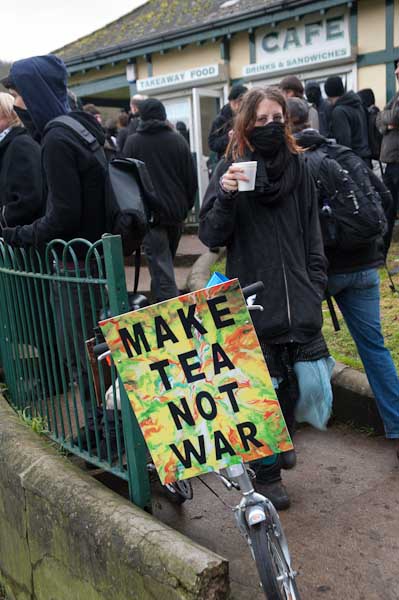
Make tea not war
Those years of demonstration have also been years of confrontation and harassment by the police although during Monday’s demonstration the police did appear to be trying to adopt a less confrontational approach in some ways – and during the several hours I was taking pictures they clearly did not want to make any arrests – though they did make five after I left.
But they were clearly also not prepared to let the protesters get the the factory to demonstrate their, blocking off the road leading to it. And although the protesters more or less surrounded the factory estate during the protest they did not manage to break through the police protecting it.

The dress code for the event was black – and mask up. A few decided not to wear masks.
This was an event when neither the police nor many of the protesters really want to be photographed – although the organisers of the protest do want press coverage and send out press releases. The organisers suggested that those taking part wear masks as both police and press would be taking photographs, and we were, in our rather different ways. At least one police officer was using a long telephoto on a Nikon DLSR to record pictures of individuals taking part, while others were using Sony camcorders to make a record of the action.
The march stopped on the main road where the demonstrators could see a strong police road block on the road leading up to the factory. I’d gone ahead at this point intending to photograph both the police block and then the marchers coming up towards it, and had climbed up about 20 feet on the roadside bank to get a good view. Unfortunately, at this point at least three quarters of the marchers decided to try to find another route, running up the hillside a few hundred yards behind me into the woods.
So I had to run up the hill too, and it was a pretty steep climb, and I began to feel my age. There were a couple of younger photographers with me but I soon decided to take my own time rather than try and keep up with them as we climbed perhaps a hundred feet. Then I was on my own in the middle of the wood and having to choose paths, trying to work out a likely route that would intercept the way the protesters would go. Not too easy as I’d never been here before, but I decided that since there were around 250 of them that they would get pretty spread out – mostly the paths were only wide enough for a single file – and I would be bound to come across them.
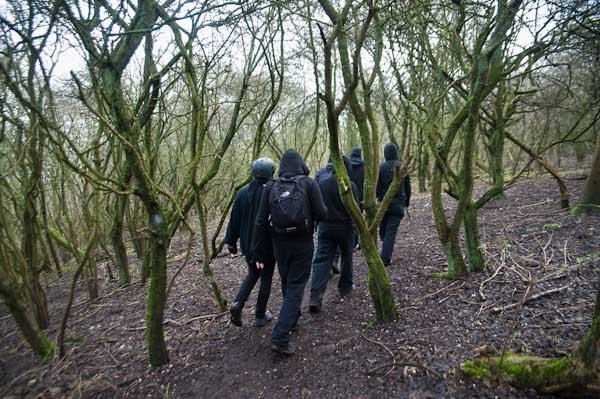
The front of the long column marching through the woods
Eventually, about seven minutes later I did, and I think I’d found a more direct route as I saw the head of the long and spread out column coming towards me. For the next ten minutes or so we wandered single file through the woods, passing quietly behind one group of police horses waiting on the edge but then we were seen by a group of police with dogs in the wood in front of us. They shouted from around 50 yards away and told us to go back or we would get bitten, and although they were too far away behind trees and bushes to get a picture I didn’t feel inclined to go closer. Although police recognise and sometimes respect a press card, police dogs don’t.
The protesters were even less keen to continue than me, and took a path away from dogs and out of the wood on the other side, where more police were waiting. For the next half hour or so, police and protesters seemed to be playing a game of some sort, with the police letting protesters through then chasing them back and finally stopping them on a path close to the factory. A couple of times the police brought in their horses to disperse the demonstrators, and the dogs were used again to threaten demonstrators who had entered a factory site next to the arms factory under a fence. There were a couple of major scrimmages, and police armed with riots shield also lent a hand. One protester was injured slightly by a baton to the head, but otherwise it was mainly a matter of pushing and shoving. Really the only thing missing was a ball.

A lot of pushing and shoving, but most protesters hung back and watched
And of course I and all the other photographers were trying to take photographs. At times there was rather a crush of photographers on some narrow paths, and tree branches really did get in the way of pictures. I did get pushed rather a lot by police, although I took care as always to keep out of the way. But a few police do sometimes seem to have a mindset that says that anyone with a camera is by definition in the way. And couple of times a police photographer gave me a fairly hefty shove so he could get a shot – where normally photographers would have respected that I was there first!
Eventually the demonstrators tired and decided it was time to go back to meet up with the rest of the protesters, and we walked back through the woods, this time accompanied by a few police officers, and down the hill to the road into Brighton.
By this time I was rather tired, and my feet were hurting. I hadn’t bargained for all the hill-climbing and off-road walking and so hadn’t worn suitable footwear. So I wasn’t pleased to find that the protesters were setting off to march back the couple of miles into Brighton, and nor were the police. A quarter of a mile down the road they tried to block the road, but chose a bad place as many of the marchers simply walked through a car park and around the block. Their second attempt wasn’t a great deal better either, and it wasn’t until the march was almost in the town centre that they did manage to stop it fairly effectively.
However it was obviously too late. The march could hardly be kept where it was blocking a major road, and once let to go on it could not be controlled in the open space of The Level and the city streets leading away from it. Issuing a Section 14 order stating it could not proceed into the city centre was surely a waste of time. As the police withdrew and came to a wider space officers rather stupidly grabbed the odd protester and others simply walked past – and eventually all had to be allowed to proceed.
I’d had enough by this time and went to the station for a train back to London and home. I think it had been an effective demonstration, getting considerable publicity in the local paper and another step in the fight to close down the arms factory. Pictures and stories – including mine front-paged on Demotix – published elsewhere helped to raise the profile of the campaign outside tle local area. You can see the pictures from the day on My London Diary.




